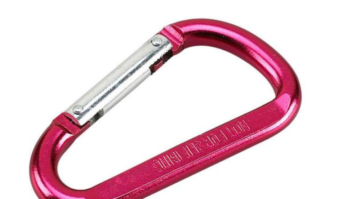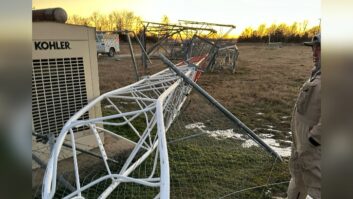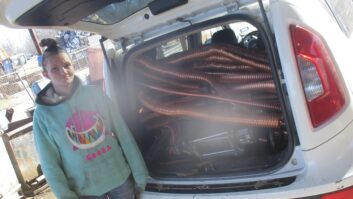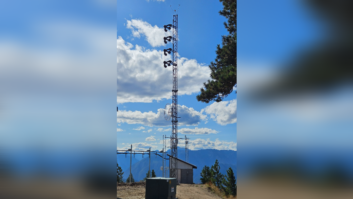Chuck Weber is chief engineer for White River Broadcasting in Columbus, Ind., and principal of Weber Climbing Services.
From rock climbing in his younger years, to a side step into tower climbing when he left active duty in the U.S. Marine Corps in 1988 and began working as a two-way radio technician, through his present position as chief engineer in southern Indiana for the last 15 years, Chuck has been doing or supervising tower work of various kinds for decades.
Chuck writes that he’s constantly asked his opinion about various tower companies. With a vendor only as good as its climbers, he refrains from recommendations, but passes along information about adding value to a standard tower re-lamp job. His tips can save stations thousands of dollars; he now shares those tips with Workbench readers. If your re-lamp job is only that, you’re losing money — or at least an opportunity.
Admittedly there is quite a difference between a sole proprietorship, such as his own weekend gig, and a large tower company that schedules your job within each traveling circuit through the area. But with a little small talk and a free lunch, Chuck finds that even crews climbing for the big dogs will give you some added benefits during your re-lamp.

Fig. 1: A cracked antenna harness is visible in the foreground of this image taken during a re-lamp visit.


Fig. 2: Your climber might also spot a broken ground kit.Fig. 3: Aquaseal and multi-use electrical tape can provide a temporary repair for an antenna heater cable. If you supply a small canvas tool bag (don’t forget the convenient carabiner clip) and the items listed below, this extra effort can pay off, especially if your climber finds and corrects minor issues during a normal re-lamp. The kicker: The task doesn’t create significant extra weight, work or time for your climber. Most things can be done quickly and easily during the frequent rest stops on the way up and/or down the tower.
Some situations will be restricted by the climber’s knowledge and experience, but most involve only common-sense repairs. Even if temporary, they can gain you time for permanent fixes before a failure occurs, such as the cracked two-bay antenna harness pictured in Fig. 1 or the broken ground strap in Fig. 2.
Chuck’s personal re-lamp tool bag contains a two-way radio and a cellphone; the latter is a backup for the radio. Never underestimate the importance of quick, easy verbal contact, even if it’s just for calling for power to check that all bulbs are operational. Two-way communication is also a safeguard against possible physical problems experienced by the climber.
Every re-lamp should include a visual inspection. It doesn’t take anything extra except the attention of the climber. Make sure you have it! The cellphone doubles as a camera for documenting problems being corrected or that may need attention soon. It’s your single most beneficial tool.
Chuck’s third item for the bag is quality electrical tape. Choose multi-use tape, “the duct tape of the tower world.” This precious addition can make the difference between a simple repair now or an early and expensive failure later.
The fourth item is Aquaseal. This urethane repair adhesive/sealant, coupled with electrical tape, can save you from an early failure on many fronts — from replacing a poor or missing STL connector weather seal to stuffing in a poorly fit wire entry to a fixture or junction box as seen in Fig. 3.

Fig. 4: Unsecured coax blowing in the wind eventually will fail. A fifth consideration is a three- to five-foot coiled length of #14 solid conductor THHN wire. Rarely does Chuck do a re-lamp where there’s not a section of coax hanging loose as seen in Fig. 4. The wire also can be used to repair missing retainer clips on side-lamp domes temporarily. That’s just a couple of uses for copper tie wraps that can be cut to length as needed. Even if the problem is with a renter’s cable, it can save you from dealing with additional climbs by other entities and the possibility of a misplaced boot. (Chuck has had a lot of climbs precipitated by the “carelessly misplaced boot.”)
A misconception is that commonly used black UV plastic tie wraps for small coax will not fail. Even the big heavy duty/UV variety will break eventually. When one does, expect a cascading effect on the other tie wraps. Copper tie wraps last virtually forever.
Chuck likes to include a multi-tool and screwdriver combo in the bag. Obvious uses include tightening cable clamps or electrical connections and removing the base of a broken bulb.
Remember to order and supply extra bulbs, at least one beacon and one side-lamp. Even new bulbs sometimes fail upon power up — or can be bad out of the box! You want a complete re-lamp with new bulbs, no old ones left in place because a new bulb failed. Old bulbs can be shelved for future use. The expense of additional bulbs is cheap insurance for a complete re-lamp.
Thanks to Chuck for these practical tips.
Contribute to Workbench. You’ll help your fellow engineers and qualify for SBE recertification credit. Send Workbench tips to [email protected]. Fax to (603) 472-4944.
Author John Bisset has spent 46 years in the broadcasting industry and is still learning. He handles West Coast sales for the Telos Alliance. He is SBE certified and a past recipient of the SBE’s Educator of the Year Award.












